Global diversity of sponges (Porifera)
- PMID: 22558119
- PMCID: PMC3338747
- DOI: 10.1371/journal.pone.0035105
Global diversity of sponges (Porifera)
Abstract
With the completion of a single unified classification, the Systema Porifera (SP) and subsequent development of an online species database, the World Porifera Database (WPD), we are now equipped to provide a first comprehensive picture of the global biodiversity of the Porifera. An introductory overview of the four classes of the Porifera is followed by a description of the structure of our main source of data for this paper, the WPD. From this we extracted numbers of all 'known' sponges to date: the number of valid Recent sponges is established at 8,553, with the vast majority, 83%, belonging to the class Demospongiae. We also mapped for the first time the species richness of a comprehensive set of marine ecoregions of the world, data also extracted from the WPD. Perhaps not surprisingly, these distributions appear to show a strong bias towards collection and taxonomy efforts. Only when species richness is accumulated into large marine realms does a pattern emerge that is also recognized in many other marine animal groups: high numbers in tropical regions, lesser numbers in the colder parts of the world oceans. Preliminary similarity analysis of a matrix of species and marine ecoregions extracted from the WPD failed to yield a consistent hierarchical pattern of ecoregions into marine provinces. Global sponge diversity information is mostly generated in regional projects and resources: results obtained demonstrate that regional approaches to analytical biogeography are at present more likely to achieve insights into the biogeographic history of sponges than a global perspective, which appears currently too ambitious. We also review information on invasive sponges that might well have some influence on distribution patterns of the future.
Conflict of interest statement
Figures
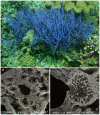
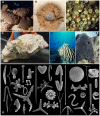


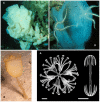
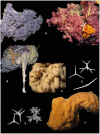
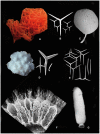







Similar articles
-
Assessing the complex sponge microbiota: core, variable and species-specific bacterial communities in marine sponges.ISME J. 2012 Mar;6(3):564-76. doi: 10.1038/ismej.2011.116. Epub 2011 Oct 13. ISME J. 2012. PMID: 21993395 Free PMC article.
-
Biopotentials of marine sponges from China oceans: past and future.Biomol Eng. 2003 Jul;20(4-6):413-9. doi: 10.1016/s1389-0344(03)00066-2. Biomol Eng. 2003. PMID: 12919827 Review.
-
Diversity in a Cold Hot-Spot: DNA-Barcoding Reveals Patterns of Evolution among Antarctic Demosponges (Class Demospongiae, Phylum Porifera).PLoS One. 2015 Jun 19;10(6):e0127573. doi: 10.1371/journal.pone.0127573. eCollection 2015. PLoS One. 2015. PMID: 26091103 Free PMC article.
-
Australian freshwater sponges with a new species of Pectispongilla (Porifera: Demospongiae: Spongillida).Zootaxa. 2016 Nov 20;4196(1):zootaxa.4196.1.3. doi: 10.11646/zootaxa.4196.1.3. Zootaxa. 2016. PMID: 27988681
-
Interocean patterns in shallow water sponge assemblage structure and function.Biol Rev Camb Philos Soc. 2020 Dec;95(6):1720-1758. doi: 10.1111/brv.12637. Epub 2020 Aug 19. Biol Rev Camb Philos Soc. 2020. PMID: 32812691 Review.
Cited by
-
Marine Staurosporine Analogues: Activity and Target Identification in Triple-Negative Breast Cancer.Mar Drugs. 2024 Oct 5;22(10):459. doi: 10.3390/md22100459. Mar Drugs. 2024. PMID: 39452867 Free PMC article.
-
The Effects of Sampling and Storage Conditions on the Metabolite Profile of the Marine Sponge Geodia barretti.Front Chem. 2021 May 10;9:662659. doi: 10.3389/fchem.2021.662659. eCollection 2021. Front Chem. 2021. PMID: 34041223 Free PMC article.
-
Nearly complete 28S rRNA gene sequences confirm new hypotheses of sponge evolution.Integr Comp Biol. 2013 Sep;53(3):373-87. doi: 10.1093/icb/ict071. Epub 2013 Jun 8. Integr Comp Biol. 2013. PMID: 23748742 Free PMC article.
-
Biological Activity of Recently Discovered Halogenated Marine Natural Products.Mar Drugs. 2015 Jun 30;13(7):4044-136. doi: 10.3390/md13074044. Mar Drugs. 2015. PMID: 26133553 Free PMC article. Review.
-
Tracing animal genomic evolution with the chromosomal-level assembly of the freshwater sponge Ephydatia muelleri.Nat Commun. 2020 Jul 27;11(1):3676. doi: 10.1038/s41467-020-17397-w. Nat Commun. 2020. PMID: 32719321 Free PMC article.
References
-
- Bergquist PR. Sponges. London: Hutchinson; 1978. 268
-
- Müller WEG. Sponges (Porifera) Berlin: Springer; 2003. 258
-
- De Goeij JM, Van den Berg H, Van Oostveen MM, Epping EHG, Van Duyl FC. Major bulk dissolved organic carbon (DOC) removal by encrusting coral reef cavity sponges. Mar Ecol Prog Ser. 2008;357:139–151.
-
- Vacelet J, Boury-Esnault N. Carnivorous sponges. Nature. 1995;373(6512):333–335.
-
- De Vos L, Rützler K, Boury-Esnault N, Donadey C, Vacelet J. Atlas of sponge morphology. Atlas de morphologie des éponges. Washington & London: Smithsonian Institution Press; 1991. 117
Publication types
MeSH terms
LinkOut - more resources
Full Text Sources
Other Literature Sources

